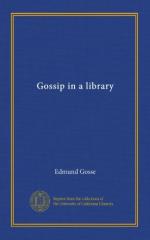According to his editor and continuator, Thomas Johnson, who speaks of Gerard with startling freedom, this excellent man was by no means well equipped for the task of compiling a great Herbal. He knew so little Latin, according to this too candid friend, that he imagined Leonard Fuchsius, who was a German contemporary of his own, to be one of the ancients. But Johnson is a little too zealous in magnifying his own office. He brings a worse accusation against Gerard, if I understand him rightly to charge him with using Dr. Priest’s manuscript collections after his death, without giving that physician the credit of his labours. When Johnson made this accusation, Gerard had been dead twenty-six years. In any case it seems certain that Gerard’s original Herbal, which, beyond question, surpassed all its predecessors when it was printed in folio in 1597, was built up upon the ground-work of Priest’s translation of Dodonaeus. Nearly forty years later, Thomas Johnson, himself a celebrated botanist, took up the book, and spared no pains to reissue it in perfect form. The result is the great volume before us, an elephant among books, the noblest of all the English Herbals. Johnson was seventy-two years of age when he got this gigantic work off his hands, and he lived eleven years longer to enjoy his legitimate success.
The great charm of this book at the present time consists in the copious woodcuts. Of these there are more than two thousand, each a careful and original study from the plant itself. In the course of two centuries and a half, with all the advance in appliances, we have not improved a whit on the original artist of Gerard’s and Johnson’s time. The drawings are all in strong outline, with very little attempt at shading, but the characteristics of each plant are given with a truth and a simplicity which are almost Japanese. In no case is this more extraordinary than in that of the orchids, or “satyrions,” as they were called in the days of the old herbalist. Here, in a succession of little figures, each not more than six inches high, the peculiarity of every portion of a full-grown flowering specimen of each species is given with absolute perfection, without being slurred over on the one hand, or exaggerated on the other. For instance, the little variety called “ladies’ tresses” [Spiranthes], which throws a spiral head of pale green blossoms out of dry pastures, appears here with small bells hanging on a twisted stem, as accurately as the best photograph could give it, although the process of woodcutting, as then practised in England, was very rude, and although almost all other English illustrations of the period are rough and inartistic. It is plain that in every instance the botanist himself drew the form, with which he was already intelligently familiar, on the block, with the living plant lying at his side.




